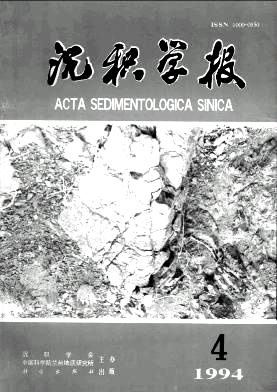Braided Delta Depositional System and Coal Accumulation During Early Late Permian Period in Eastern Yunnan and Western Guizhou,Southwest China
- Received Date: 1993-05-25
- Publish Date: 1994-12-10
-
Key words:
- Braided delta system /
- Coal-accumulation /
- Xuanwei Formation
Abstract: Late Permian Xuanwei Formation(corresponding to Longtan and Changxing Formations) in the eastern Yunnan and western Guizhou consists of coal-bearing clastic sequences. Some thick bedded basalt conglomerates were developed at the bottom of the sequence ( Lower Member of Xuanwei Formation).In this paper, the distribution and the depositional environments of the conglomerates are investigated and their relations to the coal-accumulation are discussed. The cotlglomerates are distributed to the east of Xiaojiang Fault (S-N trend ) along the east side of the Kangdian paleocontinent and they are displayed in four E-W trend belts. Our researches are focused on the Xundian-Fuyuan-Panxian conglomerate belt. Gravels of conglomerates are 5cm to 25cm in size, well rounded, middle to well sorted and gravel supported. The contents of gravels are mainly basalt fragments and occasionally siliceous rocks, tufaceous rocks and agates. The matrix consists of fine sands, plant debris and siliceous, calcareous and glauconitic cements.Sometimes marine algae fossils can be found in martix. These conglomerates are believed to be the deposits of braided delta depositional system. The main facies are pebbly braided channel conglmerates with erosional bottom and unidirectional imbricated structures. sandy braided channel sandstones with trough cross stratification and many erosional bases,pebbly mouth bar conglomerates with evident bidirectional grain orientation,and sandy mouth bar sandstones and siltstones with upward coarsening sequence and many tidal flat muddy pebble and tidal lamination.During the activation of marginal fault(Xiao jiang Fault),the progradation of each braided delta will produce an irregular upward-coarsening delta front sequence. But in some areas, the basal conglomerate beds directly cover on the paleoweathering surface on the top of Lower Permian. These basal conglomerates are probably the results of the rapid progradation of braided channel and the tidal winnowing during the initial strong activity stage of marginal fault. The coal accumulation were controlled by the braided-delta. During progradation of delta,the coal-accumulation mainly occured at the inter-channel areas on the delta plain. During retrogradation of braided delta,the coal-accumulation occured on the gradully abandoned delta lobes. As a result,at the lower part of the Lower Member of Xuanwei Formation,which was formed during the progradation of delta, the coal seams are restrictly distributed,thin and discontinuous. At the upper part, which was formed during the retrogradation of delta, the coal seams are generally thick and continuously distributed. In the inter-delta lobe areas, the coal seams are well developed both at the lower part and upper part. It can be concluded that the coa-accumulation is favored in the inter-delta areas and on the declined delta lobe.
| Citation: | Shao Longyi, Zhang Pengfei, Chen Daizhao, Luo Zhong. Braided Delta Depositional System and Coal Accumulation During Early Late Permian Period in Eastern Yunnan and Western Guizhou,Southwest China[J]. Acta Sedimentologica Sinica, 1994, 12(4): 132-139. |






 DownLoad:
DownLoad: